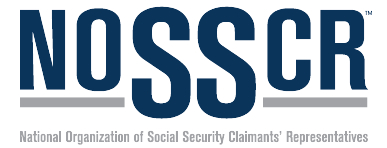04 Sep Social Security Disability Insurance: The Truth Behind Media and Political Mischaracterizations
 On August 25, The Hill published a commentary by NOSSCR’s Executive Director Barbara Silverstone. The piece, entitled “SSDI: The truth behind media and political mischaracterizations” was submitted in response to recent attacks on the Social Security Disability program that repeat misconceptions its growth. The response below provides accurate explanations for the increase in applicants, the need for representatives, and the integrity of the program:
On August 25, The Hill published a commentary by NOSSCR’s Executive Director Barbara Silverstone. The piece, entitled “SSDI: The truth behind media and political mischaracterizations” was submitted in response to recent attacks on the Social Security Disability program that repeat misconceptions its growth. The response below provides accurate explanations for the increase in applicants, the need for representatives, and the integrity of the program:
The Social Security Disability Insurance (SSDI) program is an integral part of the Social Security system that provides vital economic security to workers and their families. SSDI provides modest but essential coverage that American workers earn, and protects against the economic devastation that often accompanies life-changing disability. Unfortunately, recent media coverage (including recent opinion pieces in The Hill) has painted a highly inaccurate picture of this program, in an effort to encourage damaging changes that would hurt people with disabilities.
Eligibility criteria for the SSDI program are extremely strict and only people with the most significant disabilities qualify for benefits. An applicant must prove with medical evidence the inability to engage in “substantial gainful activity” (defined as earning less than $1,070 monthly in 2014), due to a physical or mental impairment expected to result in death or last for at least one year. Most applicants are denied; only about 40% are approved, a fact which belies claims that there is a “systematic bias” toward approving applicants who are not actually disabled.
People with disabilities turn to the program as a last resort, often having attempted to continue working after it is no longer healthy to do so and having spent down their savings before applying. There is no evidence that people are leaving the labor force to receive SSDI. While it is true that SSDI applications increased during the recent economic downturn, approval rates also declined. In fact, the current approval rate is the lowest it has been in 40 years.
Growth in the SSDI program has long been predicted by the Social Security Chief Actuary and is due almost entirely to two demographic factors: the aging of the baby boomers and women entering the workforce. According to the SSA, program growth has peaked and is projected to level off.
The SSDI program is complex so it is not surprising that many applicants choose to retain a representative, given the importance of the outcome. Having an experienced professional provide assistance is valuable for people with disabilities. Representatives help ensure that applicants provide SSA with all relevant medical evidence and help the agency make the right decision as early in the process as possible. SSA’s policies and procedures to regulate representatives do a good job of dealing with the very small number of representatives who violate the rules.
Notably, Congress has not uncovered any evidence of fraud in the SSDI program beyond the cases SSA itself uncovered, after several years of investigation. Nor has Congress found any evidence that people who should not be eligible are wrongly approved. Senator Coburn has been quoted on the topic and appears to mischaracterize what his 2012 investigation actually found. That investigation reviewed only 300 appeals decisions from just 3 counties, and his staff questioned the quality of about 25% of the written decisions but did not claim the decisions were wrong. In fact, the investigation did not find that a single individual was approved who should have been denied.
The Social Security Administration does a good job of identifying potential fraud in the program, despite its woefully inadequate recent funding levels and resources. SSA’s administrative budget is only about 1.4 percent of benefits paid out each year. However, Congress has provided nearly $1 billion less than requested over the past three years. SSA’s program integrity work has suffered too, receiving $421 million less than authorized over the last two years. The result? SSA has lost more than 11,000 employees since 2011 – a heavy blow to the agency’s ability to serve the American people.
If Congress is serious about protecting the integrity of this program, it should start by providing SSA with adequate funding to do so. It should enact H.R. 4090, the Social Security Fraud and Prevention Act of 2013, introduced by Representative Xavier Becerra (D-CA) earlier this year. It would provide SSA with dedicated mandatory funding for program integrity activities, strengthen fraud detection activities, and increase penalties for people convicted of exploiting the program.
The SSDI program does not need significant changes. It has provided economic security to workers who become disabled, and their families, for more than 50 years. But Congress does need to enact legislative changes to secure the future of Social Security and prevent cuts for SSDI beneficiaries in 2016. A rebalancing of the Old Age Survivors Insurance and Disability Insurance trust funds through reallocation of the payroll tax going into each of the funds, approved by Congress multiple times in the past, would account for demographic shifts and solve short-term funding gaps. This program is a key piece of our national social insurance infrastructure and it needs to be kept strong for current and future generations.
Silverstone is executive director of the National Organization of Social Security Claimants’ Representatives. Previously she served as staff attorney for NOSSCR for more than 20 years.
The article can also be accessed on The Hill’s site: http://thehill.com/blogs/congress-blog/healthcare/215601-ssdi-the-truth-behind-media-and-political-mischaracterizations
NOSSCR




Sorry, the comment form is closed at this time.